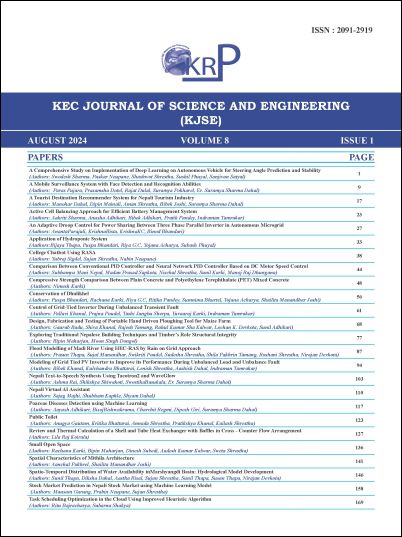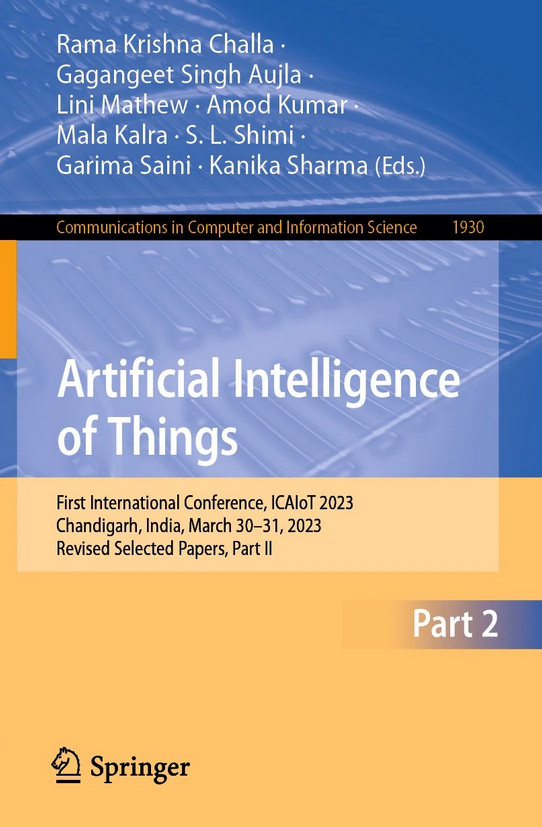Publications
2025
- MDPI Electricity
 An Optimized H5 Hysteresis Current Control with Clamped Diodes in Transformer-Less Grid-PV InverterSushil Phuyal, Shashwot Shrestha, Swodesh Sharma, and 3 more authorsElectricity, 2025
An Optimized H5 Hysteresis Current Control with Clamped Diodes in Transformer-Less Grid-PV InverterSushil Phuyal, Shashwot Shrestha, Swodesh Sharma, and 3 more authorsElectricity, 2025With the rise of renewable energy penetration in the grid, photovoltaic (PV) panels are connected to the grid via inverters to supply solar energy. Transformer-less grid-tied PV inverters are gaining popularity because of their improved efficiency, reduced size, and lower costs. However, they can induce a path for leakage currents between the PV and the grid due to the absence of galvanic isolation. This leads to serious electromagnetic interference, loss in efficiency, and safety concerns. The leakage current is primarily influenced by the nature of the common mode voltage (CMV), which is determined by the switching techniques of the inverter. In this paper, a novel inverter topology of Hysteresis Controlled H5 with Two Clamping Diodes (HCH5-D2) is derived. The HCH5-D2 topology helps decouple the AC part (Grid) and DC part (PV) during the freewheeling period to make the CMV constant, thereby reducing the leakage current. Additionally, the extra diodes help reduce voltage spikes generated during the freewheeling period and maintain the CMV at a constant value. Finally, a 2.2 kW grid-connected single-phase HCH5-D2 PV inverter system’s MATLAB simulation is presented, showing better results compared to a traditional H4 inverter.
2024
- KEC OKRP Journal
 A comprehensive study on implementation of deep learning on autonomous vehicle for steering angle prediction and stabilitySwodesh Sharma, Puskar Neupane, Shashwot Shrestha, and 2 more authorsKEC J. Sci. Eng., Sep 2024
A comprehensive study on implementation of deep learning on autonomous vehicle for steering angle prediction and stabilitySwodesh Sharma, Puskar Neupane, Shashwot Shrestha, and 2 more authorsKEC J. Sci. Eng., Sep 2024The development of autonomous vehicles has recently enhanced the transportation industry and opened up a variety of opportunities and problems that can be solved with the aid of current methods and technology. In this study, three separate algorithms were used to predict the steering angle with a track image: Artificial Neural Network (ANN), Convolution Neural Network (CNN), and a combination of CNN and Long-Short Term Memory (CNN-LSTM). The PID controller was employed for benchmarking, which takes Cross-Track Error (CTE) provided by the simulation to steer the vehicle. To achieve improved performance, the standard NVIDIA CNN self-driving model was slightly altered by feeding it with sequential frames. The comparison analysis was conducted using the OpenAI Gym Donkey Simulator.
- BJS
 Innovating Automated Progress Tracking System (APS) for Laparoscopic Simulation Training in Low-Middle-Income-Countries Using LaApSi Models: Low-Cost High-Fidelity Performance Assessment System with Microcontroller ConnectivityB B Karki, S Sharma, P Neupane, and 5 more authorsBritish Journal of Surgery, Jul 2024
Innovating Automated Progress Tracking System (APS) for Laparoscopic Simulation Training in Low-Middle-Income-Countries Using LaApSi Models: Low-Cost High-Fidelity Performance Assessment System with Microcontroller ConnectivityB B Karki, S Sharma, P Neupane, and 5 more authorsBritish Journal of Surgery, Jul 2024To develop a Low-Cost Automated Progress tracking system (APS) embedded in the silicon based Laparoscopic Appendicectomy Simulation (LaApSi) Model which enables real-time assessment of Laparoscopic Appendicectomy (LA). To assess its application and validity in the low-resource setting via Laparoscopic Surgery courses.APS architecture includes thin insulated wires embedded in the LaApSi Models at the mesoappendix, appendicular artery, and the base of the appendix which acts as an indicator when cut during the appendicectomy. These wires are further connected to the Printed Circuit Board (PCB) located at the base of the model which connects with the microcontroller and establishes communication with the computer giving real-time data.The prototyped APS model was able to establish key features: 1. Total duration of the procedure 2. Identify potential surgical hazard: blood vessel injury 3. Length at which the appendicectomy is performed 4. Injury to surrounding structures. These performance data were recorded in the database for further review, analysis, and comparison for progression in the simulation training. The system is set up on a points basis hence when a user makes a surgical error e.g., blood vessel injury during the surgical simulation in the APS LaApSi Model, -20 points (Blood Vessels Cut) appear on the computer screen (images available). Further assessment and validity of the APS models are planned to be carried out in low-resource settings in the next 8 weeks.The availability of a model blueprint of this cost-effective APS system (\<20£) to LMICs will address the key barrier of surgical simulation in low-resource settings.
- BJS
 Application of Low-Cost Automated Progress Tracking System (APS) on Laparoscopic Appendicectomy Simulation Models (LaApSi) for the Laparoscopic Simulation Training in the Lower-Middle-Income-Countries (LMICs)B B Karki, S Sharma, P Neupane, and 5 more authorsBritish Journal of Surgery, Jul 2024
Application of Low-Cost Automated Progress Tracking System (APS) on Laparoscopic Appendicectomy Simulation Models (LaApSi) for the Laparoscopic Simulation Training in the Lower-Middle-Income-Countries (LMICs)B B Karki, S Sharma, P Neupane, and 5 more authorsBritish Journal of Surgery, Jul 2024To assess the effectiveness of the Low-Cost Automated Progress Tracking System on Laparoscopic Appendicectomy (LA) Simulation Models (LaApSi) for Laparoscopic Training in Lower-Middle-Income-Countries (LMICs). To assess and record the progression of trainees’ performance during simulation training.After the successful application and validation of the LaApSi model during laparoscopic courses at LMICs, the APS system has been prototyped to assess the trainee’s progression of LA. This system helps to assess surgical steps during simulated LA with the help of the LaApSi model integrated with wires at various anatomical positions giving real-time computer feedback and allowing users to assess the timing of operation, blood vessel excision and injury to the base of the appendix/caecum.The prototype version tested in LMIC showed excellent results in the detection of the above-mentioned parameters (shown in photos). This cost-effective model (LaApSi\< £5 and docking system \<£15) showed huge potential as a laparoscopic training model in LMICs. There will be additional validation of 16 APS models during the Laparoscopic Surgery Course in Nepal in Jan 2024 in collaboration with Nepalese Doctors Association-UK which we believe will further solidify its application in the LMICsThere is a need for the transition to high-fidelity low-cost laparoscopic simulation models from the traditional training methods in the LMICs which in the long-term address global surgery values. These systems have the potential for remote proctorship in the rural parts adapting the Hub \& Spoke model and integrating AI and Machine Learning which eliminates the use of wires and sensors in the models.
2023
- Springer ICAIoT
 Predictive Load Management Using IoT and Data AnalyticsSushil Phuyal, Shashwot Shrestha, Swodesh Sharma, and 2 more authorsIn Artificial Intelligence of Things, Jul 2023
Predictive Load Management Using IoT and Data AnalyticsSushil Phuyal, Shashwot Shrestha, Swodesh Sharma, and 2 more authorsIn Artificial Intelligence of Things, Jul 2023The objective of this paper is to design and implement an Internet of Things (IoT) based energy data acquisition system that incorporates a Long Short Term Memory (LSTM) model for predicting household energy demand and optimizing energy consumption with load scheduling and shifting. To achieve this goal, the system feeds 7 days’ worth of energy consumption data, along with relevant features such as temperature, humidity, precipitation, and holiday information, into the LSTM model to predict the energy demand curve. The system categorizes loads into deferrable and non-deferrable loads. Based on these categories, the system applies load scheduling techniques to flatten out the demand curve and optimize energy consumption. In addition, the system shifts the deferrable loads from the grid to renewable sources during peak hours if available. This helps to reduce the burden on the main grid and promotes sustainability. Furthermore, the system takes into account the day-ahead hourly price-based tariff rate, ensuring that energy consumption is cost-effective. This is achieved with a prototype Predictive Load Management Device (PLMD). To relay information to the users, the system includes a web-based application made in Blynk that presents the information in a simple, easy-to-understand format. This reduces the complexity associated with different techniques of demand-side management (DSM) and makes it accessible to users with varying technical backgrounds. The web-based application allows users to monitor energy consumption patterns, view predictions generated by the LSTM model, and make informed decisions on energy consumption intuitively and straightforwardly.
@inproceedings{10.1007/978-3-031-48781-1_13, doi = {https://doi.org/10.1007/978-3-031-48781-1_13}, author = {Phuyal, Sushil and Shrestha, Shashwot and Sharma, Swodesh and Subedi, Rachana and Khan, Shahabuddin}, editor = {Challa, Rama Krishna and Aujla, Gagangeet Singh and Mathew, Lini and Kumar, Amod and Kalra, Mala and Shimi, S. L. and Saini, Garima and Sharma, Kanika}, title = {Predictive Load Management Using IoT and Data Analytics}, booktitle = {Artificial Intelligence of Things}, year = {2023}, publisher = {Springer Nature Switzerland}, address = {Cham}, pages = {153--168}, isbn = {978-3-031-48781-1}, url = {https://link.springer.com/chapter/10.1007/978-3-031-48781-1_13}, }